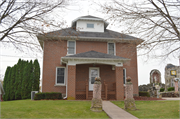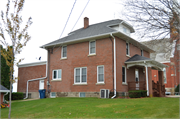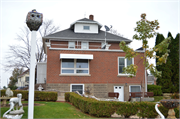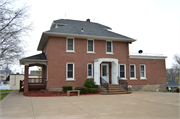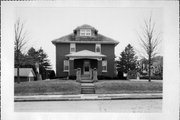Property Record
305 W MAIN ST
Architecture and History Inventory
| Historic Name: | Holy Ghost Rectory |
|---|---|
| Other Name: | Holy Ghost Rectory |
| Contributing: | Yes |
| Reference Number: | 55791 |
| Location (Address): | 305 W MAIN ST |
|---|---|
| County: | Grant |
| City: | Dickeyville |
| Township/Village: | |
| Unincorporated Community: | |
| Town: | |
| Range: | |
| Direction: | |
| Section: | |
| Quarter Section: | |
| Quarter/Quarter Section: |
| Year Built: | 1930 |
|---|---|
| Additions: | |
| Survey Date: | 19952016 |
| Historic Use: | rectory/parsonage |
| Architectural Style: | American Foursquare |
| Structural System: | |
| Wall Material: | Brick |
| Architect: | |
| Other Buildings On Site: | |
| Demolished?: | No |
| Demolished Date: |
| National/State Register Listing Name: | Not listed |
|---|---|
| National Register Listing Date: | |
| State Register Listing Date: |
| Additional Information: | A 'site file' titled 'Holy Ghost Parish Historic District' exists for this property. It contains additional information such as correspondence, newspaper clippings, or historical information. It is a public record and may be viewed in person at the Wisconsin Historical Society, State Historic Preservation Office. 1995- "Holy Ghost Park is more well-known as the Dickeyville Grotto sculpture park. The complex is on the south side of West Main Street. Starting from the east along Main street, the first part of the complex is the gates to Holy Ghost Park. Then comes the rectory garage, then the rectory [55791], then an open space that is part of the sculpture park, then the grotto [both 44363], then the church [55789] and then the schoolhouse [55790]. The sculpture park extends southward behind the rectory and the grotto. Behind the church and the school is a large cemetery. Since this is a site with several resources, each will be discussed separately. Rectory: A simple, Four-Square house, two stories high, with a hipped roof and red brick siding. The house has a center-front door sheltered by a small porch with brick corner piers, a slight Tudor arch in the cornice and a hipped roof. The railing is modern. A large double-hung window trimmed with a molded brick flat-arched top and a stone or concrete sill flanks the porch to each side. Two smaller windows, also with one-over-one sash, pierce the second story. The narrow frieze of the eaves rest directly above these windows. A large gherkin-headed dormer crowns the crest of the roof and has a grouping of two double-hung windows and shingle siding. The roof is a Dutch-lap shingle roof. A row of soldier bricks forms the beltcourse above the basement, which is faced in rusticated concrete block. This house is shown under construction in a photograph in the collections of the State Historical Society of Wisconsin, dated 1929, and a datestone over the door trimmed in small decorative stonework of similar construction to the grotto says "1930." The rear porch area has been enclosed and modernized. To the east of the rectory is a low, gable-roofed, two-car garage with a cement foundation and red brick walls. Holy Ghost Church began as a small mission church attached to a Catholic church in nearby Kieler. It was established in 1873, the same year that Dickeyville is said to have begun. In 1873-1874 a small frame church building was erected that was described in The Catholic Church in Wisconsin as "plain in exterior" but with a nice painting of the Holy Ghost descending on Mary that was dedicated in 1893. In 1895 the congregation included 48 families of a total of 53 families who lived in Dickeyville. The large brick church was built in 1913. According to an 1895 map of Dickeyville, a schoolhouse was in use by the late 19th century. The current school building dates to 1919. The Holy Ghost sculpture park is the highlight of this complex. The park was the creation of the pastor of the church, Father Matthias Wernerus. Wernerus was born in 1873 and served as pastor of Holy Ghost Church from 1918 until his death in 1931. He began his grotto in 1925 and worked diligently on it until 1930. Rev. Wernerus' cousin and housekeeper, a Miss Wernerus, assisted in the effort. Although they were both elderly at the time, they "toiled early and late for nearly five years mixing Portland cement and lifting rocks that would tax a man's strength" (Gregory, p. 567). Gregory further describes their effort: "The work was begun on a small scale, but took on increased proportions while it proceeded. As word traveled that such an edifice was to be, donations began to pour in. Stones came from every land inhabited by man, and the work went on. One central shrine is built at the east of the church proper, which is twenty-five feet high, about twenty feet wide and thirty feet long. The American flag is on one side and the Papal flag on the other, a "tree of faith," depicting "the seven gifts of faith," is shown in the rock. statues of the twelve apostles adorn a walk. Fences around the cemetery are covered with stone and colored glass flowers. Gregory concludes by describing a dispute that was taking place in 1932 over the $9000 in donations that were given to the grotto each year. Rev. Wernerus intended it to go to the congregation, but the Bishop became interested in the funds. How the dispute was resolved awaits further research." The church complex would be historically and architecturally significant even if the grotto did not exist. The church is an excellent example of turn-of-the-century church architecture and retains a great deal of its historic integrity. The rectory and schoolhouse contribute to the historic setting of the complex. The grotto and sculpture park, however, are superb examples of the grotesque style of folk sculpture that was associated often with Catholicism but is not common due to the great deal of work required to create it. The Dickeyville grotto is one of the finest examples of this type of folk sculpture remaining in the state, other examples of which include the Holy Family Grotto at the Villa St. Joseph in the Town of Washington, La Crosse County, the St. Phillips Grotto in Rudolph in Wood County and the Paul Wegner grotto in rural Sparta." -"USH 151, Dickeyville to Belmont", WisDOT# 1209-02-00, Prepared by Katherine Hundt Rankin (Preservation Consultant) for Rust Environment & Infrastructure Inc, 1995. 2016- "The district is comprised of approximately 5.3 acres, encompassing two tax parcels with multiple contributing and non-contributing resources. The Parish property currently contains the church [AHI#55789], school [55790], rectory [55791], cemetery [232926], and several utilitarian buildings. These buildings in the district represent the second generation of Parish buildings, built to accommodate a growing congregation after the first church, school, and rectory became too small or outdated. They are generally unified in appearance, despite their construction dates spanning approximately 20 years, by their red brick walls atop limestone foundations. In addition, the current Parish property contains the scattered elements of the Holy Ghost Park [44363], a series of shrines and grottos designed and constructed by Father Mathias Wernerus during his tenure as parish priest. The second tax parcel of the district contains the former convent [232925] for the teaching sisters of the school. The Holy Ghost Rectory is a two-story, simplified American Foursquare residence constructed in 1930. The rectory is rectangular in plan with a rock-faced limestone foundation, red brick walls, and a hipped roof with clipped gable dormers on the front and rear elevations. The front elevation faces northeast and is symmetrical, with a central multi-light door under a hipped roof porch supported by square brick piers. On either side of the porch is a replacement 1-over-1 double-hung window. Windows on the second story are located closer to the center of the facade, and are also 1-over-1 replacements. The dormer, originally filled with wooden shingles and a pair of 1-over-1 windows, has been filled in with vinyl siding and a single, fixed-pane window since the time of the 1995 survey. Decorative brick work throughout the rectory is limited to a soldier brick cornice band just above the level of the foundation, and soldier brick lintels above the windows of the first story. Further alterations include the infill of an entry door on the west elevation, which provided access to the gift shop that was formerly located in the Rectory." -"Holy Ghost Parish Historic District", WISDot#1650-07-02, Prepared by UWM-CRM, (2016). |
|---|---|
| Bibliographic References: |
| Wisconsin Architecture and History Inventory, State Historic Preservation Office, Wisconsin Historical Society, Madison, Wisconsin |

